The Andrew Smith Gallery presents an exhibit of photographs by Mexican photographer Flor Garduño titled Inner Light: Still Lifes and Nudes, opening Friday, July 11, 2003, with a reception for the artist from 5-7 p.m. The exhibit contains approximately 35 silver and platinum/palladium prints by Mexico's acclaimed photographer. The exhibition is a celebration of Garduño's most important body of work since Witnesses of Time.
In conjunction with Photo Arts Santa Fe (July 11- 20), Flor Garduño will be at the opening of the exhibition. Additionally, there will be a lecture about her work followed by a question and answer session and booksigning, July 13, 2003, from 2:00 to 4:00 p.m. at The Anne and John Marion Center for Photographic Arts at the College of Santa Fe.
Flor Garduño has been described as a "poet-photographer." Her powerful images of native peoples throughout the Americas, along with her symbolic nude studies and lyrical still-lifes, bridge the threshold between the sacred/temporal worlds, and allow viewers to glimpse what Carlos Fuentes called "the moving portrait of eternity." Once an assistant to Manuel Alvarz Bravo, Garduño quickly found her own independence and vision when she made numerous trips to remote parts of Latin America in the 1980s to photograph the lives and rituals of indigenous people. Her book of this work, Witnesses of Time (1992), was published in six editions and became an international success with exhibitions of the photographs traveling to major museums around the world.
Around this time Garduño gave birth to her second child, an event which made her decide to change how she made photography. Setting up a homemade studio in a small adobe shed next to her house in Tepoztlán, she proceeded to "return to the beginning," concentrating on still lifes and female nudes. She photographed her women friends, encouraging them to chose their own poses. "This collection," said Garduño, "is the product of a collaboration among many friends. It was a circular process, many of these friends wanted to make their own sculptures of themselves, create in their own images." Enriched by her experiences being a mother, Garduño saw the potential in each of her subjects. "Each figure glows as if it were fervently embracing a promise, beaming with an overwhelming fullness," writes Verónica Volkow in her introduction to the book, Flor Garduño: Inner Light - Still Lifes and Nudes, 2002. The exhibit continues through August 10, 2003.
The photographs in "Inner Light" describe a deeply personal realm in which the artist wanders through the multi-faceted territory of the mythic feminine. In her small studio Garduño photographed her friends and still-lifes within a shallow depth of field against the neutral backdrop of cracked adobe floor and walls. It is as if her camera lens were searching out the procreative life force as it invisibly coils through curves of flesh, radiates from the amulet of a baby's hand, springs from calla lilies between a woman's breasts, or slips between a woman's fingers as a snake. The atmosphere Garduño created in her studio was truly fecund. Not only did leaves, flowers and fruit bare their stamens, pistils and seeds to her camera, seven out of ten models became pregnant soon after they were photographed by her. It became a joke among her women friends that if someone wanted to become pregnant they should pose for Flor Garduño.
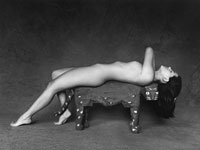
In "Gatomonte, Mexico, 1998," a nude young woman reclines on a wooden bench carved by a folk artist into the shape of a mountain lion. The woman's head impassively faces the ceiling, her eyes are closed and she might be asleep. The carved head of the cat glares menacingly at the camera, as if protecting its sleeping charge. Two years later Garduño photographed the same model, now pregnant, lying on the same bench in, "Gatamonte preñado, Mexico, 2000."
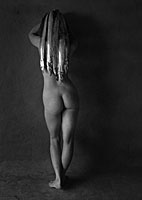
Garduño is well versed in world mythology. In "Medusa, México, 1998," we are not allowed to see the face of the woman who stands naked with her back to the camera. The figure both attracts and repels, for instead of hair five eel-like fish extend from the top of her head to the middle of her back. The shimmering fish scales contrast with the woman's voluptuous body linking her to the ocean and the unconscious.
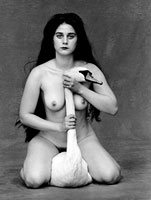
"Mito, Suiza, 2001" is a contemporary image of the Greek myth about Leda and the Swan. In fact the word mito means myth. A striking, dark haired woman with languid eyes kneels in front of the camera, serenely straddling a swan. She gently holds its long neck in both hands against her breasts, her white skin nearly matching the swan's downy feathers.
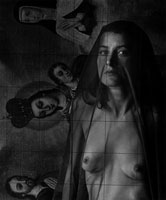
Garduño incorporates elements from Catholic iconography in some of her images. She also revises the traditions by emphasizing women's empowering connection to the natural world. In "Comuníon, México, 2000," a young girl covered by a sheer veil of white fabric holds a large calla lilly instead of a cross or monstrance. The veiled woman in "Magdalena, México, 1999" stands before a Mexican painting of saints and holy figures turned on its side. To see the woman the viewer must look through a screen of fine grid lines on the surface of the photograph, as well as through the dark veil that covers her. The Magdalene was traditionally viewed as the woman who sinned and repented. But for many contemporary people she represents the earthy, sexual side of women that the Church has tried to exclude.

"Terciopelo negro, Mexico, 1999" is an image of a slender, elongated woman who reclines at the base of the photograph. The model's head is concealed behind the folds of a black curtain, eliminating anything that might distract us from the soft highlights on her dark skin. Garduño has a keen eye for art history. Her model recalls the sensuous nudes of Modiglinani or Ingres.
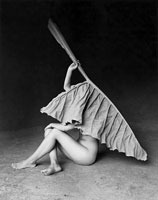
Garduño is clearly familiar with the French primitive painter Henri Rousseau's stage-like tableaux of steamy jungle scenes, leaping acrobats, and sleeping gypsies. Like Rousseau's painting "The Dream" in which a nude woman lies on a red couch surrounded by jungle foliage, "Hoja elegante, México, 1998," is a whimsical photograph of a seated nude woman who has covered herself with a gigantic tropical leaf.
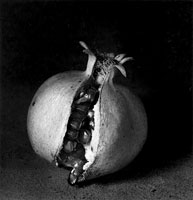
In her still lifes Garduño frequently chooses round ripe fruits, as in "Con Corona, México, 2000", in which a pomgranate's moist seeds spill from the husk. "Los limones, Mexico, 1998" is a twist on the conventional still-life. Garduño invokes the viewer's sense of touch in this platinum/palladium print of a platter of lemons in the foreground. Light and shadow play on their pebbly surfaces emphasizing their nipple-like stems. Garduño playfully reminds us that luscious fruit can be as erotic as the human form by contrasting the lemons with the buttocks and breasts of a nude model lying in the shadows behind them.
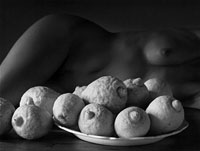
Throughout these photographs Garduño delights in the passive quality of the feminine principle. Her nude models lie on the floor, drape themselves over furniture, and allow other forms to touch them. In contrast, a powerful image of the active, implacable aspect of the feminine is found in "Macho y hembra, Mexico, 1983."
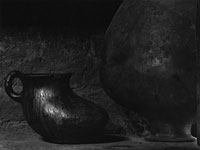
A muscular woman stands before the camera, her legs apart and her arms uplifted over her head. Her face is hidden behind the hilt of an enormous sword that bisects her entire body and pierces the ground between her feet.
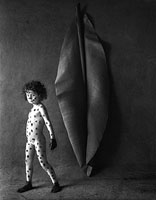
Garduño's young daughter, Azul, occasionally appears in work. In "Ocelote Azul, Mexico, 1998," the child is painted with black spots and her hands and feet are black. With her eyes on the camera this child of nature strides next to a giant leaf twice her height, wary as a baby leopard.
Flor Garduño was born in Mexico City in 1957 and grew up there. She studied at the Academy of San Carlos and then became assistant to master photographer Manuel Alvarez Bravo. Garduño's photographs are in the collections of the MOMA in New York, the G.P. Getty Museum in Los Angeles, and Stiftung fur Fotographie of Zurich. She has published numerous books including Magic of the Eternal Game, 1985; Bestiarium, 1987; Witnesses of Time, 1992, Mesteños, 1994, and Flor Garduño: Inner Light - Still Lifes and Nudes, 2002. Her photographs from Witnesses of Time were exhibited in over forty museums around the world including the Art Institute of Chicago, the Center for Creative Photography in Tucson, and in numerous international cities. Flor Garduño, her husband and two children divide their time between Mexico and Switzerland.
Liz Kay